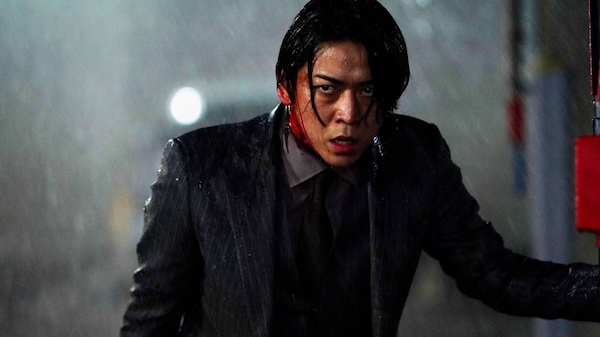Film Review: “Lumberjack the Monster” — A Petrified Forest
By Steve Erickson
Director Takashi Miike’s latest is a killjoy of a film: it doesn’t want to have fun with its material, but it’s impossible to take it seriously.
Lumberjack the Monster, directed by Takashi Miike. Streaming on Netflix

Kazuya Kamenashi in a scene from Lumberjack the Monster.
Takashi Miike directed 31 films before his US breakthrough Audition. The hefty volume of his filmography, which now totals 122, is intimidating. That may explain why Audition has become a horror classic while his other work has received much less attention. His reputation as a goremeister is far from unearned: anyone who sat through Ichi the Killer’s human tempura torture scene can testify that he’s gone much further in gleeful bad taste than Audition. But that kind of mayhem doesn’t define his entire oeuvre, which also, for example, includes ultra-stylized children’s movies. The prolific eclecticism of his work makes it a challenge to single out the standouts. Miike used to claim that he filmed every script he was offered. This isn’t a recipe for consistency, but it offers manifold opportunities to learn on the job. In any case, the director has distanced himself from the direct-to-video market for which he churned out low-budget work throughout the ’90s. His last three projects have been produced by Disney/Hulu (the TV series Connect), Apple (the short Midnight, which is up on YouTube), and Warner Bros. Japan (Lumberjack the Monster, which began streaming on Netflix US on June 1.)
A tale of a lawyer with no conscience hunting down the man who attempted to kill him, Lumberjack the Monster promises a fresh return to very familiar subject matter. Given that Netflix is doing less than zero to promote the film, I’d love to report that it’s a major effort in danger of being overlooked. But that would be far from the truth — over the course of two lethargic hours Lumberjack the Monster stretches out some pretty thin material. The fast-moving virtues of the grubby B-movie, so key to Miike’s early work, are entirely gone here.
The opening juxtaposes an illustrated children’s book about the titular creature, who worries about what his nature may be, with the efforts of the police attempting to arrest a woman who’s stored the bodies of 15 children in vats in her house. As she’s about to be captured, she slices her throat with a knife. (The original timeline, which explains the full significance of this scene, is explained much later.) Akira (Kazuya Kamenashi) is attacked in a parking garage by an axe-swinging man outfitted in full mask and costume. He narrowly avoids becoming the latest victim of a serial killer who cuts open his prey’s heads in order to dispose of their brain matter. Although two cops are put on the case, Akira himself turns out to be a capable detective, dedicated to hunting down the man who nearly killed him. (Also helpful is his best friend, a surgeon who brags about experimenting on people, having moved up from killing cats.) It turns out that Akria is just as psychopathic as his target: the lawyer’s first onscreen murder inspires a gush of blood that rhymes visually with the suicide of the woman in the opening scene. A clue to the anti-hero’s violent streak and affectlessness — as well as the motivations of the serial killer — emerges when a medical scan shows a chip implanted in his brain.
The first half of Lumberjack the Monster looks like a dark, glossy police procedural. It is a lot brisker than the material that follows, but not much distinguishes these scenes from TV shows that cover the same ground. The second half purports to examine the nature of monstrosity and the value of human emotional connections, but the proceedings bog down in an exposition dump, especially once Akira unmasks the villain. The potential for interesting psychological exploration is strong. Lumberjack the Monster might have delved into the pathos of a man whose “monstrosity” was imposed upon him against his will. (Think of the protagonists of David Cronenberg’s Rabid and Scanners.) Instead, the attempts at analysis of motive and character development become embarrassingly silly. The fact that the psychopaths here are enormously successful in white collar jobs hints at a political critique — but it goes no further than that observation. (Keep this film away from Elon Musk: it might give him some horrific new uses for Neuralink!) The problem is that by halfheartedly trying to take an ‘explanatory’ route, Lumberjack the Monster turns its back on serving up perverse, gory genre fare. It doesn’t fully commit to either approach — so the most promising aspects of its storyline are ignored.
Kamenashi retains the androgynous prettiness of the boy band member he began his career as. He nails Akira’s underlying blankness, but he’s not convincing as someone who’s lived a cripplingly difficult life or is trying to break out of an emotionless shell. But what can you do with a role and a story this clichéd? (Of course, the main investigating cop bends the rules and breaks the law in her quest for justice.) Lumberjack the Monster is a killjoy of a film: it doesn’t want to have fun with its material, but it’s impossible to take it seriously.
Steve Erickson writes about film and music for Gay City News, Slant Magazine, the Nashville Scene, Trouser Press, and other outlets. He also produces electronic music under the tag callinamagician. His latest album, Bells and Whistles, was released in January 2024, and is available to stream here.
